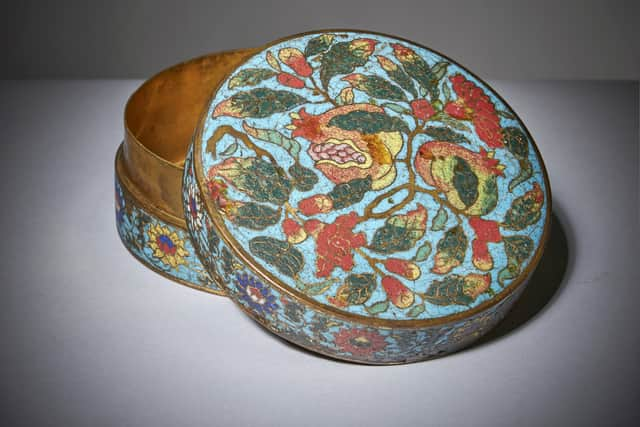Old tin found in attic turns out to 1400s antique made for Chinese emperor - and could fetch tens of thousands
and live on Freeview channel 276
An old tin found in a family’s attic has turned out to be a rare antique treasure that could fetch tens of thousands at auction. The tiny decorated box was made for a 15th century Chinese emperor and has been squirrelled away in a cabinet in a family’s attic since 1967.
Adorned by depictions of two ripe pomegranates with gnarled golden branches, the decorative circular tin was bought by a decorated army Major at an auction held shortly after the end of the Second World War. It was later displayed at a museum in South Africa where he had been based before being returned to England - where it has sat untouched and covered in dust in the attic of the Major’s home until now.
Advertisement
Hide AdAdvertisement
Hide AdExperts believe the box, which is one of just five still in existence, was made for Emperor Xuande, the fifth Emperor during the Ming dynasty of 1426 to 1435. Adding to the boxes’ worth is the fact it is now one of just two remaining boxes not being held in museums.
The slightly damaged piece will go under the hammer at an auction held by Dreweatts next month and is tipped to have the potential to fetch even more than the initial estimate of £10,000. Experts explained their disbelief that the brightly-coloured box was only recently discovered in the dust-filled attic of the family home where it had been stored and left untouched since the death of its owner, Major Edward Coplestone Radcliffe, in 1967.
The box was found to bear the incised six-character marks of Xuande, the fifth Emperor of the Ming Dynasty. Emperor Xuande - real name Zhu Zhanji - reigned over a decade of relative peace between 1426 and 1435 and was said to be personally fond of painting and literature.
Major Radcliffe purchased the box from an auction held by Sotheby’s in London back in 1946, and later had it exhibited at the National Gallery of South Africa’s Chinese Exhibition in Cape Town, where he lived for a period. Despite numerous copies it is one of just five known examples, one of which is held at the Palace Museum in Beijing.
Advertisement
Hide AdAdvertisement
Hide AdJust one other box is similarly held in private hands. On the historical significance of the box, Dr Yingwen Tao, a specialist in Chinese and Asian Art at Dreweatts, explained the boxes were likely made for the Emperor himself.
Dr Tao said: "There is every indication that all five were made in the same imperial workshop, for the Emperor, as crucially all are doubly marked with an incised Xuande six-character reign mark on the underside of the box and the interior of the cover. They also all have similar designs and are uniform in size, at 12cm in diameter."


On the discovery of the artefact which appeared “too good to be true”, director of Asian Ceramics and Works of Art at Dreweatts, Mark Newstead, said the valuation only came after a friend of the family referred it to him. When I first inspected the piece it looked too good to be true, as 99.9 per cent of Xuande-marked pieces are later copies.
"The mark is one of the most copied of all time - used every decade since the Xuande reign - and is found on pieces from the 16th, 17th, 18th, 19th and 20th centuries. I assumed it was made in the 16th or early 17th century and it was only when my colleague Dr Yingwen Tao was able to compare it with the example at Fenton House that we started to believe it could be a ‘lost’ example of this rare group."
Advertisement
Hide AdAdvertisement
Hide AdCloisonné enamel pieces from the early Ming period are exceptionally rare, due to production being strictly regulated by the palace eunuchs who operated under the auspices of the Yuyongjian; a subdivision of the Neifu or the “Inner Treasury” responsible for supplies to the Imperial Household.


The box will be offered for sale for the first time in 77 years alongside some of Major Radcliffe’s other collected works during Dreweatts’ Chinese Ceramics & Works of Art & Japanese, Indian & Islamic Ceramics & Works of Art sale on May 17 and 18. Initial estimates suggested it could fetch between £6,000 and £10,000.
But Mr Newstead added: "This initial estimate was based on it being from the 17th century, but it is now looking extremely modest and it’s thought it could achieve much more, even in its slightly damaged condition."
